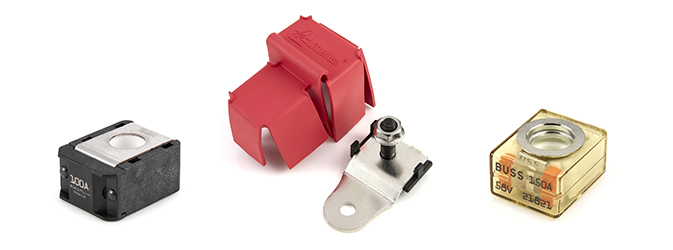Six Reasons to Use Fuses Instead of Fusible Link or Wire
Fusible link and fusible wire are still found in many OEM vehicles, intended as a simple way to protect electrical circuits from overheating (fusible link is a short piece of wire designed to melt and break the circuit under excessive current conditions; fusible wire does the same thing but with the entire wire acting as a fuse).
When specified and used with care, fusible link and wire can indeed protect circuits, especially in situations where minor surges or spikes are expected occur. However, when it comes to heavy-duty and specialty vehicles and equipment, there are many reasons to consider using an automotive fuse (along with a corresponding fuse holder) instead of fusible link or wire. Among them:
- Fast reaction. Fuses react quickly to overcurrent situations, providing a high level of protection against short circuits and major surges. Fuses are rated and tested to fail under precise overcurrent conditions. The current rating allows the fuse to break when the current exceeds a specific safety threshold. Fusible link/wire tends to fail more gradually and doesn’t offer the same precision of protection for specific levels of overcurrent.
- Replacement. Automotive fuses are designed to be easily replaced. When a fuse blows, you simply swap it out with a new fuse of the appropriate rating. If a fusible link or wire fails, it can be more complex and time consuming to replace because the wire itself needs to be replaced and properly sized.
- Availability. Automotive fuses are widely available and come in a broad range of standardized sizes and amp ratings, making them easy to find and order. Fusible link/wire is not amp-rated the way fuses are. As a result, each fusible link/wire installation is unique and must be designed to meet specific circuit protection requirements.
- Safety. Fuses are contained in fuse holders, which provide a protective enclosure reducing the risk of short circuits, accidental contact, and potential fire hazards. Fusible link/wire will melt or flame out when it fails, presenting a potential heat or fire hazard—not to mention a mess to clean up afterwards.
- Industry Ratings. Fuses adhere to well-defined industry standards and ratings, ensuring consistency in protection levels and compatibility with various systems. Fusible link wire might lack the same levels of standardization, leading to potential compatibility issues.
- Affordability. Automotive fuses commonly found near the battery or alternator are cost-competitive compared to most fusible link and wire, while providing all the advantages listed above.
Conclusion
As a rule, fusible link or wire takes longer to overheat and withstands excessive current for longer periods of time than fuses. However, it also carries risk of damaging nearby wiring and components when it melts or flames out. For added safety, ease of replacement, and peace of mind in protecting your automotive wiring and electrical equipment, you can’t go wrong with a properly rated fuse and fuse holder. If space or accessibility is an issue, check out low-footprint, battery-mountable fuses such as ZCASE Mega/Starter fuses from Littelfuse or MRBF fuses from Eaton.
To learn more about how to select and use automotive fuses, see the Waytek article Fuses 101: What You Need to Know.
To learn more about fuse holders, see Fuse Holders 101.
See the full range of automotive fuses available on the Waytek website.

Subscribe Now
Subscribe and be the first to know when new articles are published.
